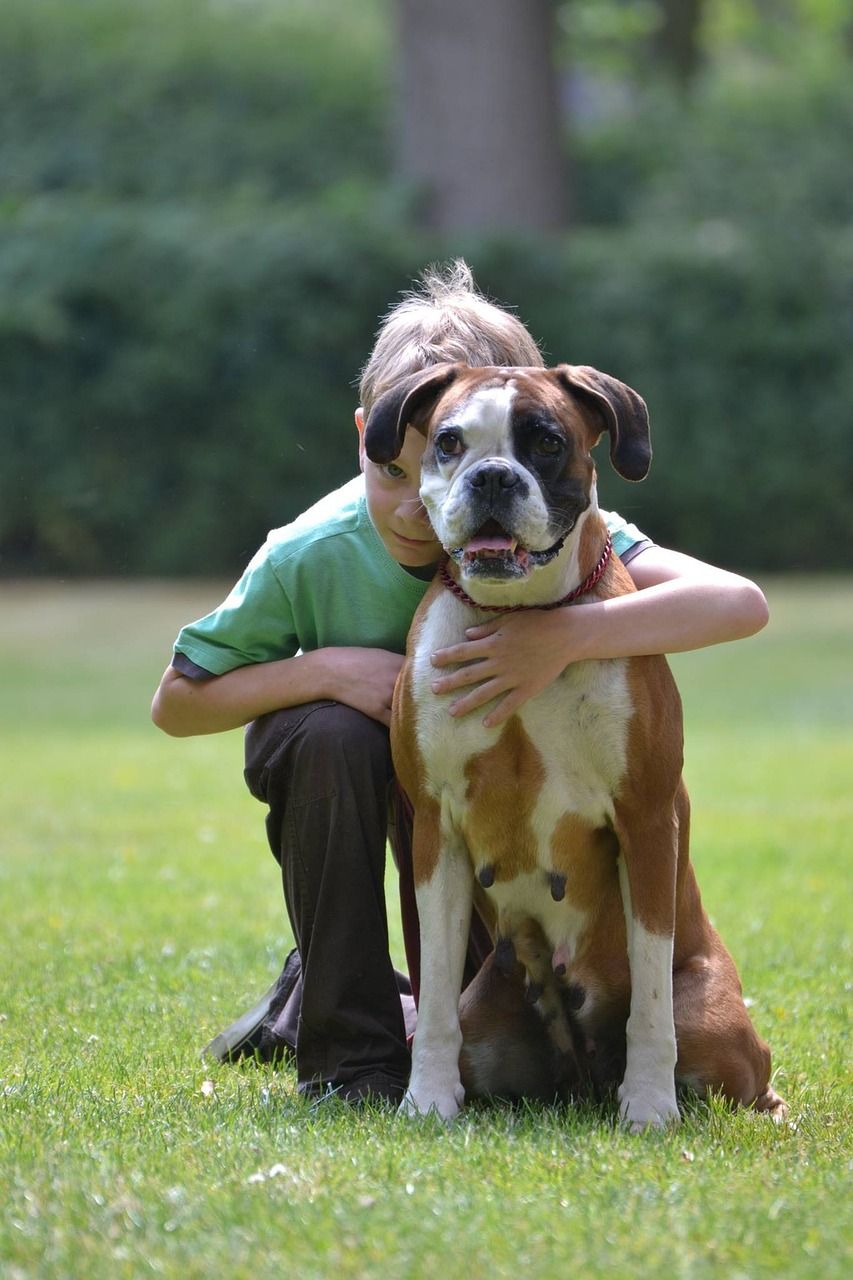You've seen them at dog parks, those muscular, short-haired dogs with a playful demeanor. Boxers. And as you watch them dash around, you might wonder, "Can Boxer dogs run long distances?" Dive into the world of Boxers, as we unravel the facts about their stamina, athleticism, and running capabilities.

The Origin and Purpose of the Boxer Breed
Understanding the stamina of any dog breed begins by diving into its origins. Boxers hail from Germany, bred primarily from the Old English Bulldog and the now-extinct Bullenbeisser. Initially, they were used for hunting large game, requiring them to chase and hold down the prey until the hunters arrived. This ancestral role gives us the first clue about their stamina: Boxers were built for short, intense bursts of energy, rather than prolonged runs.
Boxer Dogs' Physical Attributes: A Closer Look
To answer the question, "Can Boxers run long distances?", let's examine their physique. Boxers possess a muscular build, compact body, and a broad chest, attributes that typically denote power and strength. However, these physical characteristics are designed for quick spurts rather than marathons.
Health and Stamina: The Heart of the Matter
Boxers are known for their athleticism. A well-conditioned Boxer can, indeed, accompany you on a longer run. However, the keyword here is "well-conditioned". If your Boxer isn't accustomed to running long distances, starting off with shorter runs and gradually increasing the distance can help build their stamina.
Another aspect to consider is their health. Boxers are prone to certain ailments like hip dysplasia and heart conditions. It's essential to get your Boxer's health checked before undertaking any rigorous running routine.
Are Boxers Good Distance Runners?
In truth, Boxers can adapt to a variety of activities. With proper training, they can manage moderate distances. However, remember, their original role wasn't that of a long-distance runner. Pushing a Boxer to run extended distances without adequate preparation can lead to unnecessary strain and potential injuries.
Running Tips for Boxer Owners
If you're eager to start a running routine with your Boxer, here are some guidelines to consider:
- Start Slowly: Just as humans can't jump from a sedentary lifestyle to a marathon overnight, neither can Boxers. Begin with short distances and observe how your dog copes.
- Weather Considerations: Boxers have a short coat and a shorter snout, which makes them susceptible to extreme weather conditions. It's best to run during cooler parts of the day.
- Regular Health Check-ups: As mentioned, Boxers can be prone to certain health issues. Regular vet check-ups ensure your dog is in top shape for physical activity.
- Stay Hydrated: Always carry water for both you and your Boxer. This breed can get dehydrated quickly, especially during physical exertion.
Boxer Dogs Running Limitations
While Boxers are playful and energetic, long-distance running might not be their forte. Their physical attributes and health considerations play a significant role in determining their running capacity.
Understanding Boxer Dogs’ Unique Physiology
Boxers are brachycephalic, which means they have a shortened skull shape resulting in a short nose and flat face. This anatomy can make breathing more difficult, especially during intense physical activity. The structure of their respiratory tract is compact, which can make airflow less efficient than in longer-snouted breeds.
The Brachycephalic Consideration
For brachycephalic breeds like Boxers, long-distance running can pose challenges. When running, especially in hot or humid conditions, Boxers can struggle to take in enough air to meet their increased oxygen demand. This can lead to overheating and, in severe cases, heatstroke.
Tailoring the Run to Your Boxer
Not all Boxers are the same, and each dog will have its unique stamina level and running capacity. Here are a few tailored strategies:
- Frequent Breaks: Since Boxers can overheat, consider breaking your run into shorter intervals with walking or resting breaks in between. This approach gives your Boxer time to recover and breathe easier.
- Choose Your Terrain Wisely: While Boxers have sturdy builds, they might appreciate softer terrains like grass or dirt over hard pavements. Such terrains can be gentler on their joints and paws.
- Observe and Adapt: Always watch for signs of fatigue in your Boxer. If they start to lag behind, pant excessively, or show disinterest, it might be time to slow down or end the run.
The Boxer's Age and Running
Age plays a critical role in determining how far and fast a Boxer can run. Puppies, with their boundless energy, might seem like they can run forever, but their bones and joints are still developing. Overexertion can lead to long-term health issues.
Senior Boxers, on the other hand, might have the heart and spirit to run, but their bodies might not cooperate. It's essential to adapt the distance and pace to the age and physical condition of your Boxer.
The Boxer's Health and Long-Distance Running
One of the most crucial aspects to consider when involving Boxers in any extended physical activity is their overall health. Several health factors can influence their ability to run long distances.
Breathing and Respiratory Health
Given their brachycephalic nature, Boxers have a unique respiratory system. This design can sometimes limit their oxygen intake, especially during rigorous activities. Running in high humidity or extreme heat can exacerbate breathing problems. It's paramount to ensure your Boxer doesn't show signs of respiratory distress during or after runs.
Joint and Bone Health
Just like humans, Boxers can experience wear and tear on their joints and bones. Repetitive, high-impact activities, like running on hard surfaces, can increase the risk of issues like arthritis, especially in older dogs. Incorporating supplements, vet-approved of course, can help maintain joint health and flexibility.

Proper Training and Conditioning
Boxers, like all dogs, benefit from gradual conditioning. If you're keen on involving your Boxer in running:
- Build Up Gradually: Start with short distances and slowly extend the range as your dog builds stamina.
- Incorporate Intervals: Alternate between running and walking to avoid overtaxing your Boxer's system.
- Monitor Recovery: Note how quickly your Boxer recovers after each run. Heavy panting or extended fatigue can indicate that you might be pushing too hard.
Safety Precautions for Running with Boxers
Ensuring the safety and well-being of your Boxer should always be a priority. Here are some safety tips to consider:
- Stay Hydrated: Always carry enough water for both you and your dog. Boxers can become dehydrated quickly.
- Watch the Paws: Hot pavements can be harmful to your Boxer’s sensitive paw pads. Invest in protective footwear or try to run during cooler parts of the day.
- Use a Suitable Harness: Using a harness instead of a collar can provide better support and control while running, without putting undue strain on your Boxer's neck.
Alternative Activities for Boxers
While long-distance running may not be the go-to activity for Boxers, they thrive in many other forms of exercise. Consider these:
- Hiking: A moderate-paced hike can be an excellent way for Boxers to explore new environments, use their muscles, and get exercise without the repetitive impact of running.
- Tug-of-War: This game helps them use their strong jaw muscles and offers an excellent physical workout.
- Training Sessions: Teaching your Boxer new tricks or commands can be both mentally stimulating and physically taxing, especially when it involves movement.
Boxers and Their Energetic Needs
While Boxers might not be the ideal long-distance runners, their energetic nature can't be denied. They are brimming with vitality and require consistent physical activity to remain healthy, mentally stimulated, and content.
Understanding Their Energy Levels
Boxers, especially during their younger years, are balls of energy. They thrive on consistent interaction, play, and exercise. However, it's essential to channel this energy properly to prevent potential behavioral problems, such as destructive tendencies or excessive barking.
Benefits of Regular Physical Activities for Boxers
Engaging Boxers in regular physical activities goes beyond merely tiring them out. There are multiple benefits:
- Physical Health: Exercise strengthens their heart, muscles, and bones, reduces the risk of obesity, and promotes overall good health.
- Mental Health: Physical activities stimulate their minds, keeping them sharp and engaged.
- Bonding: Engaging in activities with your Boxer strengthens your bond. It fosters trust, understanding, and a deeper connection.
- Behavioral Benefits: Regular exercise can curb unwanted behaviors by giving Boxers a positive outlet for their energy.
Activities Tailored to Boxers
Knowing that long-distance running might not be their forte, here are some activities tailored to their strengths:
- Sprint Runs: Short, fast runs in a controlled environment like a fenced yard can be an excellent way for Boxers to release pent-up energy.
- Obedience Training: Not only does this mentally challenge them, but it also provides a structured way for them to expend energy.
- Playdates with Other Dogs: Social interactions can be mentally and physically tiring. Organizing playdates with compatible dogs can be beneficial.
- Interactive Toys: Toys that dispense treats or require problem-solving can engage a Boxer's mind and provide light physical activity.
Regular Check-ups and Dietary Considerations
If you're increasing your Boxer's physical activities, monitoring their diet and health is vital.
- Diet: An active Boxer may require more calories. Consult your veterinarian about the best diet, ensuring they get the necessary nutrients without becoming overweight.
- Health Check-ups: Regular vet visits will help monitor any potential health issues and ensure that your Boxer's heart, joints, and overall well-being are in top shape.

The Importance of Rest
Just as exercise is vital, so is rest. Boxers, with their muscular physique, benefit from downtime to recover and heal. Ensure they have a comfortable resting space and don't hesitate to give them a day off if they seem fatigued or less enthusiastic about exercise.
Boxer Dogs and the Urban Environment
Many Boxer owners reside in urban environments, where vast open spaces are limited. Such settings present unique challenges and opportunities for ensuring Boxers get the exercise they need.
The Urban Challenge: Limited Open Spaces
Unlike rural or suburban areas, cities often have less green space for dogs to run freely. This limitation can make it harder for Boxers to expend their energy. However, city living doesn’t mean your Boxer can't get the exercise they crave.
Adapting to City Living with Your Boxer
Dog Parks and Playgrounds
Many cities have recognized the importance of dog-friendly spaces and have established dog parks. These enclosed areas are great for off-leash play and interaction. Your Boxer can enjoy short sprints, play fetch, and mingle with other dogs.
Structured Walks
Urban environments are bustling with stimuli — cars, people, and other animals. Taking your Boxer on structured walks, where they heel by your side, can be both a mental and physical exercise. The plethora of sights and sounds keeps their mind engaged, while the walking keeps them active.
Stair Climbing
If you live in a multi-story building, stair climbing can be a great workout for your Boxer. It helps build muscle and stamina. However, be cautious and start slowly, especially if your Boxer is unaccustomed to stairs.
Indoor Play
Not every day will be suitable for outdoor activities. Bad weather, for example, might keep you indoors. But this doesn't mean playtime is canceled. Games like tug-of-war or hide-and-seek with toys can be played indoors.
Socializing in the City: A Double-Edged Sword
City living means encountering diverse people and pets. This exposure can be beneficial for your Boxer's socialization. However, always be cautious:
- Monitor Interactions: Not all dogs or people may appreciate an energetic Boxer’s approach. Be vigilant during interactions to avoid any confrontations.
- Health Concerns: Urban areas can sometimes be breeding grounds for diseases, especially in crowded dog parks. Ensure your Boxer is up-to-date with vaccinations and regular health check-ups.
Holistic Wellness for Urban Boxers
Living in the city can sometimes be stressful for dogs. The noise, the crowds, and the limited natural spaces can be overwhelming. Therefore, ensuring your Boxer's holistic wellness becomes crucial:
- Mental Stimulation: Puzzle toys, training sessions, and even simply changing walking routes can provide new stimuli and challenges.
- Calm and Comfort: Ensure your living space is comfortable for your Boxer. Consider noise-canceling solutions or calming sprays if they seem agitated by city noises.
- Regular Health Checks: Pollution and the general city environment can have health implications. Regular vet visits are essential.

Conclusion:
In understanding the Boxer breed's ability to run long distances, we've explored their physical attributes, health considerations, and energy levels. While they might not be marathon runners, Boxers possess a spirited zest for life that requires tailored activities for optimal health, be it short sprints, agility training, or structured city walks.
Their brachycephalic nature demands careful attention to respiratory health, and their energetic disposition thrives on both mental and physical stimulation. Whether in expansive rural settings or bustling urban environments, the key to a happy Boxer lies in understanding, adapting, and ensuring a balance of exercise, play, and rest.
Frequently Asked Questions (FAQs)
1. Can Boxer dogs run long distances?
Boxers aren't typically suited for long-distance running due to their brachycephalic nature, which can affect their breathing, especially during rigorous activities. However, with proper training and conditioning, they can enjoy moderate distances.
2. How can I safely exercise my Boxer?
For a safe exercise routine, start with short distances and build up gradually. Consider incorporating intervals of running and walking, always monitor their recovery, and be cautious of running in extreme heat or high humidity.
3. What are the health considerations for Boxers when running?
Boxers have unique respiratory systems, making them susceptible to breathing problems. Additionally, their joint and bone health is vital, as repetitive running can increase wear and tear, especially on hard surfaces.
4. Are Boxers suitable for city living and exercise?
Yes, Boxers can adapt to city living. While open spaces might be limited, dog parks, structured walks, stair climbing, and indoor play can keep them active. Regular socialization and health checks are crucial in urban environments.
5. How can I tell if my Boxer is overexerting during exercise?
Heavy panting, extended fatigue, limping, or reluctance to continue are signs of overexertion. It's essential to monitor your Boxer's behavior during and after exercise and adjust routines accordingly.
6. What are the best alternative activities for Boxers?
Boxers thrive in activities like hiking, tug-of-war, obedience training, and interactive play with toys. They benefit from a combination of physical and mental stimulation.




